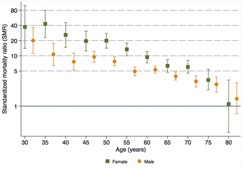Cardiovascular Mortality in Transplant Patients; A Population-Based Cohort Study 1988-2013 in Australia and New Zealand
M. Wyld1, N. De La Mata2, P. Masson3, E. O'Lone2, A. Webster2
1Renal Department, Royal Prince Alfred Hospital, Camperdown, Australia, 2School of Public Health, University of Sydney, Sydney, Australia, 3Renal Department, Royal Free London NHS Foundation Trust, London, United Kingdom
Meeting: 2019 American Transplant Congress
Abstract number: 326
Keywords: Kidney transplantation, Mortality, Outcome, Survival
Session Information
Session Name: Concurrent Session: Kidney: Cardiovascular and Metabolic II
Session Type: Concurrent Session
Date: Monday, June 3, 2019
Session Time: 4:30pm-6:00pm
 Presentation Time: 5:06pm-5:18pm
Presentation Time: 5:06pm-5:18pm
Location: Ballroom C
*Purpose: Transplant recipients experience excess cardiovascular morbidity and mortality. We compared cardiovascular death rates in kidney transplant recipients to the general population and identified risk factors for cardiovascular death in kidney transplant recipients.
*Methods: Primary cause of death for kidney transplant recipients was established through ICD-10 codes and data linkage between the Australia and New Zealand Dialysis and Transplant Registry (ANZDATA) and the national death registers of Australia and New Zealand. Cardiovascular deaths included death from ischaemic heart disease, valve disease, cardiomyopathy, arrhythmias, and cardiac failure. We used indirect standardisation to estimate standardised mortality ratios (SMR) and, Fine and Gray competing risks regression model to determine risk factors for cardiovascular mortality (subhazard ratios, SHR).
*Results: During 1988-2013, there were 5286 deaths in 17,628 kidney transplant recipients in 175,084 person-years of follow up. Of these deaths 936 (17.8%) were cardiovascular, of which 788 (84%) were caused by ischaemic heart disease. The crude rate of cardiovascular death in transplant patients fell over time from >800/100,000 person-years in the early 1990s to <400/100,000 person-years in the 2010s (p<0.001). Cardiovascular death rates increase with age for both men and women (p<0.001).Cardiovascular SMR in transplant patients was 5.46 (95%CI: 5.12, 5.82). SMRs fell over time from a high of 16.92 (95%CI: 9.61, 29.80) in 1984 to 4.03 (95%CI: 4.03, 7.05) in 2013 (p<0.001). Females had significantly higher relative cardiovascular mortality than men at all age groups until age 75 when the differences were no longer statistically significant (Figure 1).Risk factors for cardiovascular death included male sex (SHR 1.61, 95%CI:1.39,1.85), age >55 (SHR 2.97, 95%CI:2.48,3.55), >36 months on dialysis (SHR 1.63, 95%CI:1.30,2.05), pre-existing coronary artery disease (SHR 1.49, 95%CI: 1.20,1.85), and either diabetes (SHR 1.6, 95%CI:1.28, 2.0) or hypertension (SHR 1.53, 95%CI: 1.16,2.02) as the cause of kidney failure.
*Conclusions: Transplant recipients have greatly increased risk of cardiovascular mortality compared to the general population. Excess risk is much higher for female than male transplant recipients suggesting cardiovascular risks may be under-recognized, and/or prevention and treatment interventions less effective in females with ESKD.
To cite this abstract in AMA style:
Wyld M, Mata NDeLa, Masson P, O'Lone E, Webster A. Cardiovascular Mortality in Transplant Patients; A Population-Based Cohort Study 1988-2013 in Australia and New Zealand [abstract]. Am J Transplant. 2019; 19 (suppl 3). https://atcmeetingabstracts.com/abstract/cardiovascular-mortality-in-transplant-patients-a-population-based-cohort-study-1988-2013-in-australia-and-new-zealand/. Accessed December 21, 2025.« Back to 2019 American Transplant Congress

